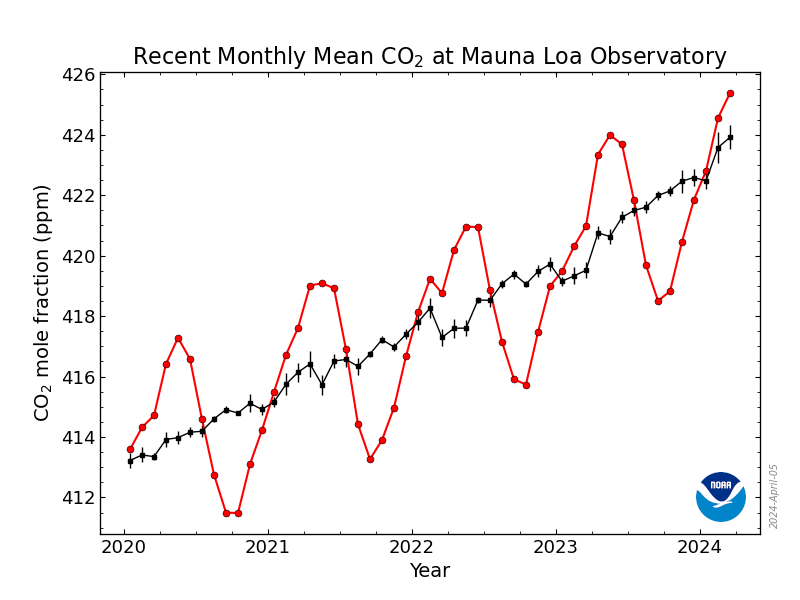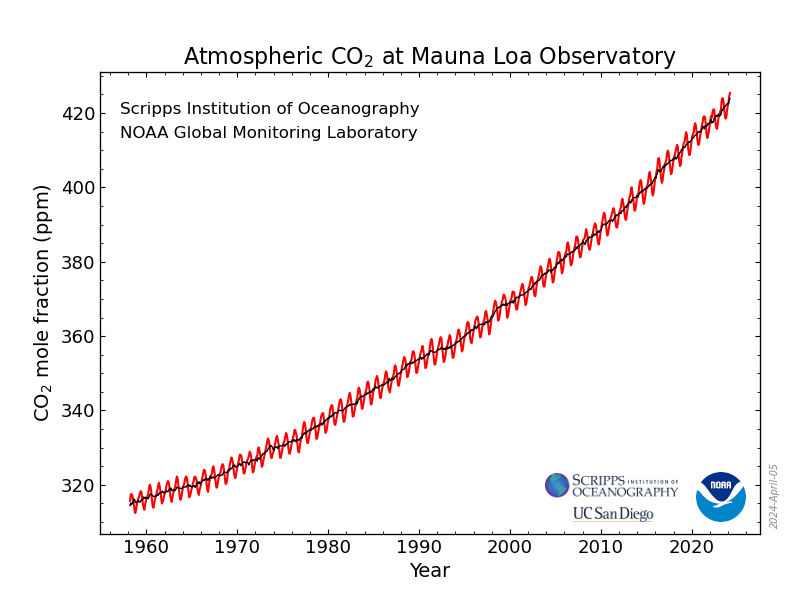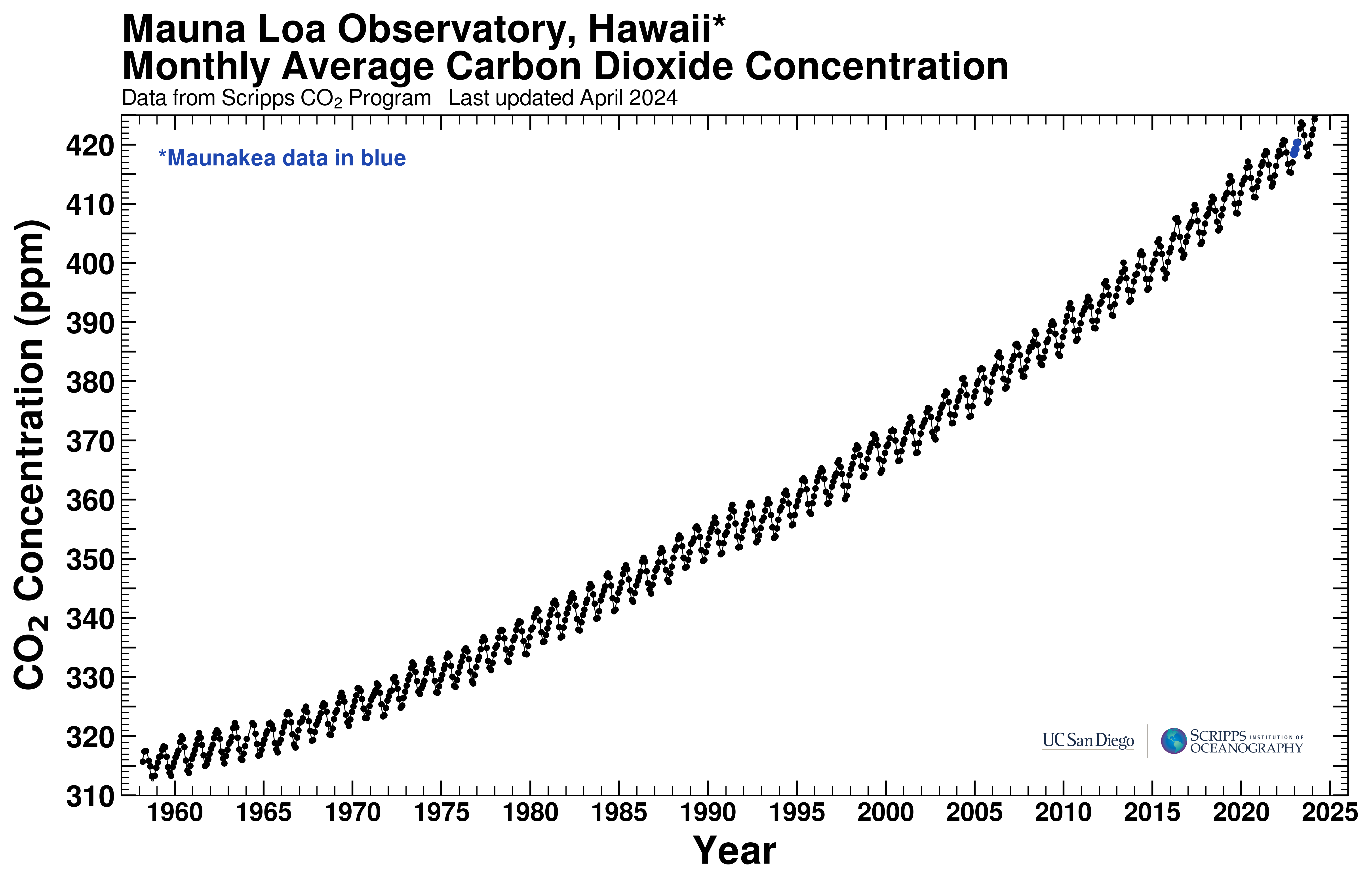Mauna Loa CO2
February 2025
NOAA-GML |
SCRIPPS UCSD |
|
| Feb. 2025 |
427.09 ppm | 427.01 ppm |
| Feb. 2024 | 424.55 ppm | 424.34 ppm |
| Feb. 2023 | 420.31 ppm | 420.33 ppm |
| Last Update: | Mar. 5, 2025 | Mar. 3, 2025 |
| View Data: | NOAA | Scripps |
Mauna Loa Observatory (MLO) | Atmospheric CO2
monthly mean concentrations | ppm = parts per million
Two independent records of CO2 changes are maintained in parallel at Mauna Loa. A graph showing the two records together is available at the bottom of the Scripps CO2 Program website. All-time monthly record highs for CO2 are recorded at the CO2 Records webpage.
Use the tabs below to view the latest monthly CO2 data, charts and related links.
Global
-
Global Monthly CO2 Data
Global Monthly CO2 Averages
November 2024
Nov. 2024
423.64 ppm
Nov. 2023
420.37 ppm
Nov. 2022
417.82 ppm
Last Update: Mar. 5, 2025 View Data: NOAA global monthly data
NOAA global trends webAtmospheric CO2
monthly mean concentrations | ppm = parts per million
NOAA-ESRL-GMD CCGG global cooperative air sampling networkNOAA-ESRL’s Global Monitoring Division (GMD) operates the largest and most comprehensive global network of air sampling sites. In the 1970s, the GMD started air sampling programs at Mauna Loa and other sites around the world. GMD network coordination activities are based in Boulder, Colorado, USA.
NOAA publishes a monthly global average based on CO2 measurements by its distributed network of air sampling sites. Global averages have usually been posted a month after Mauna Loa averages are posted. For example, the Mauna Loa average for January has often been published in the first half of February, and the global average for January has often been published in the first half of March.
Despite seasonal variations at different latitudes, readings from observatories around the world show the same rising CO2 trend from one year to the next. In the book, CO2 Rising, Tyler Volk (2008) writes, "Data from Alaska and Samoa fit right in with the trend from Mauna Loa and the South Pole, where monitoring was begun nearly 20 years earlier. We are witnessing a global phenomenon. CO2 is rising everywhere, and at about the same rate" (pp. 40 -41).
More Info
NOAA-ESRL GMD Global CO2
NOAA-ESRL GMD NOAA-ESRL calculation of global averages
NOAA-ESRL GMD Cooperative Air Sampling Network
SkS CO2 Comparison Chart | Mauna Loa vs. Global Average
SkS CO2 Comparison Chart | Mauna Loa, Alaska, Samoa, South Pole
Reference
Volk, T. (2008). CO₂ rising: The world's greatest environmental challenge (2010 paperback ed.). Cambridge, MA: MIT Press.
Charts
-
Charts for Mauna Loa CO2
Below are two NOAA charts and three Scripps charts. Each chart shows changes in CO2 concentrations at different time scales--from hourly to seasonally. These charts all use averages of readings at the Mauna Loa Observatory in Hawaii that started in March 1958.
NOAA Recent Monthly CO2 Averages
 Source Graphic NOAA-ESRL [web + png + pdf]
Source Graphic NOAA-ESRL [web + png + pdf]
NOAA Monthly CO2 Averages
Scripps Data 1958 - 1974 | NOAA Data 1974 - Present Source Graphic NOAA-ESRL [web + .png + .pdf]
Source Graphic NOAA-ESRL [web + .png + .pdf]
Scripps Monthly CO2 Averages
March 1958 - Present Source Graphic Scripps CO2 Program [web + .png + .pdf]
Source Graphic Scripps CO2 Program [web + .png + .pdf]
Scripps Hourly, Daily & Weekly CO2 Averages for the Past Month
 Source Graphic Scripps Keeling Curve [web + .png]
Source Graphic Scripps Keeling Curve [web + .png]
Scripps Daily & Weekly CO2 Averages for the Past 6 Months

Source Graphic: Scripps Keeling Curve [web + .png]
More Scripps Graphics
Scripps CO2 Program Mauna Loa Graphics Gallery
Scripps Keeling Curve Website 1 Week 1 Month 1 Year 2 Years Since 1958 Since 1700 800,000 Years
KC Monthly Web Widget
CO2.earth features this CO2 tracker on its home page using widget html code (available in several sizes) from Show.Earth.
***
-
*** More Data
Mauna Loa CO2
CO2.Earth Daily CO2 Data
CO2.Earth Weekly CO2 Data
CO2.Earth Yearly CO2 Data
CO2.Earth CO2 Trend
About the Data
NOAA How scientists measure background CO2 levels on Mauna Loa
Monthly Data at Other Stations
CSIRO Monthly GHG Data at Cape Grim, Tasmania
NOAA Monthly CO2 data (in situ) at the South Pole Observatory, Antarctica
Data Updates
Is data reposted incorrectly?
CO2.Earth Nudge Us

